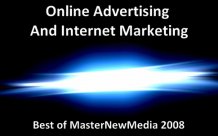Do you think an industry worth $170 billion dollars, and still growing during a recession, might have something to teach us about making money?
I think so. Especially when that industry is built entirely on a particular kind of marketing—a kind of marketing which is directly applicable to the Internet.
Direct-response advertising has been an ever-lucrative, ever-growing industry for over half a century. Its success relies entirely on a fairly small number of key principles. And with the Internet being a direct-response medium, these principles transfer directly over. Here are eight of the most important of these principles, and how they relate to us as online marketers:
1. The money is in the (right) list
What’s the one thing you absolutely must have if you’re gonna sell your product or service?
I think you’ll find it’s customers.
In direct-response advertising, customers are sought through a mailing list. The better the quality of your list, and the more people on it, the better your response rates will be and the more money you’ll make.
Online, a list can be many things. The most obvious instance is an email list. The correlation is pretty clear between sending out a ‘snail-mail’ sales letter to a mailing list, and sending out an email sales letter.
But more broadly speaking, a list is any collection of people who’ll read what you put in front of them. Blog subscribers; Twitter followers; Facebook fans; etc.
Direct-response advertisers know the money isn’t in any list, though. This is something online marketers should take note of. Rather than being concerned with building up enormous numbers of followers, they should be focused on building enormous numbers of prospects. Because if your followers are not also customers, you aren’t going to sell anything. Better to have a hundred keen prospects than a hundred thousand freeloaders who never intend to buy anything.
2. Your first words count
Original Mad-Man David Ogilvy famously noted:
On average, five times as many people read the headline as read the body copy. It follows that, if you don’t sell the product in your headline, you have wasted 80 percent of your money.
Your headline or email subject line should focus on how what you’re selling will benefit your prospect. Simply talking up yourself or your product won’t sell anything. For example, a homepage headline like “The Leading Supplier of Blue Widgets in Blue Widget County” will fall on deaf ears—even for qualified prospects who want blue widgets. On the other hand, “Blue Widgets Shipped to You Direct, Cheaper & Faster than Anyone Else—or Your Money Back” gives prospects a lot of reasons to read your copy and find out more.
As a rule of thumb, if you can read your headline and then reasonably say, “So what?”…it isn’t strong enough.
3. The only purpose of advertising is to sell
Drayton Bird is very fond of quoting American advertising pioneer Raymond Rubicam, who said:
The only purpose of advertising is to sell. It has no other justification worth mentioning.
He is very right, and this principle can seldom be repeated too often. Many marketers are unduly concerned with ‘building brand recognition’, ‘increasing customer awareness’, ‘leveraging social media’ and all these other fancy marketing techniques. But what is the point of these things if they don’t measurably lead to more sales?
Of course, brand recognition, customer awareness, social media and the like can all be used to increase sales—and significantly at that. But very often, marketers have no clear strategy as to how they should use these tools to bring in more money. Sometimes they don’t even consider the question; they just ‘know’ they should be doing these things…because everyone else is, so it must be important, right?
If you haven’t got a clear idea of how a given marketing technique will help you make more sales, don’t use it. If you’re already using it, stop immediately. On the other hand, if you do have a clear idea but lack any way to measure your success, find a way before continuing.
4. The more you tell, the more you sell
Debating the value of long versus short copy is pointless. The fact is that copy should be as long as it needs to be to sell as much as possible—and no longer. Generally speaking, that means it should be ‘long’.
Long, that is, compared to most of the marketing materials you see online.
Marketers are often afraid that if they say too much, they’ll bore their readers out of buying. Ironically, what they should actually be afraid of is not saying enough to persuade their readers to buy.
“But Bnonn, ” I hear you say, “people don’t have time to read lots of information. And attention-spans on the web are short.”
Sorry, but that’s pure, unadulterated hogwash. What you mean to say is that people don’t make time to read stuff that doesn’t interest them, and they don’t devote their attention to things with no clear benefit. In which case, refer to point #1 of this article!
If what you’re offering is interesting to the people on your list, and the benefit to them is clear, they will make the time to devote a lot of attention to it. Like you’re devoting to this article right now. What—do you think you’re different to your prospects?
5. The only kind of copy that sells is conversational copy
Internal marketing departments: listen up. Catchphrases like ‘vertically integrated’ and ‘leading provider’ are no better than jargon. They are meaningless to your prospects. And I’d dare to guess that if you had to explain them, you’d get tied in knots trying.
Regardless of your audience, your copy should be written conversationally. That doesn’t necessarily mean ‘informally’ or ‘casually’. It just means you should write to your ideal prospect in exactly the same way you would speak to him. If you’d do that casually, fine. If you’d do it more formally, that’s how you should write.
For example, imagine you run into a guy at the pub, and he mentions he needs something like what you sell. To get him interested, would you say, “We’re a leading provider of top-tier full-service solutions”…or would you say, “We can build a new website for you, from start to finish, and support it afterwards—plus help you use it to bring in new clients”?
6. You have to ask for the sale
That’s right—prospects will rarely do anything if you don’t actually ask them to. When you include a clear call to action (CTA) in your marketing materials, your response rate will naturally increase dramatically.
This is really the ‘direct response’ part of direct-response advertising: you’re asking your prospect to immediately take an action; to respond to your offer. This doesn’t necessarily mean buying something. Your offer might be a free special report. Or an email newsletter. Any link in the sales chain. But the critical thing is that you ask for a response.








